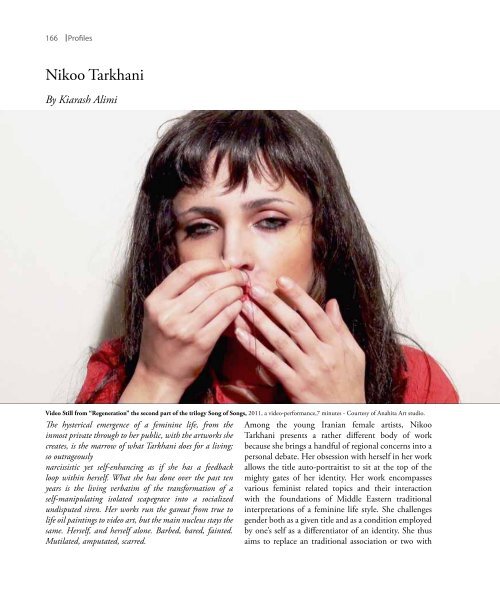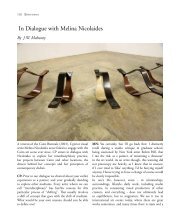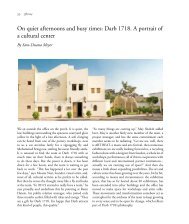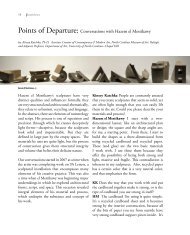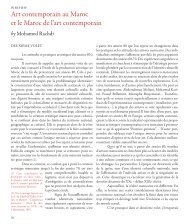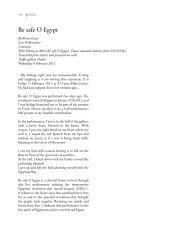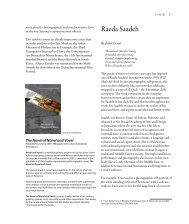Nikoo Tarkhani - Contemporary Practices
Nikoo Tarkhani - Contemporary Practices
Nikoo Tarkhani - Contemporary Practices
Create successful ePaper yourself
Turn your PDF publications into a flip-book with our unique Google optimized e-Paper software.
166 Profiles<br />
<strong>Nikoo</strong> <strong>Tarkhani</strong><br />
By Kiarash Alimi<br />
Video Still from “Regeneration” the second part of the trilogy Song of Songs, 2011, a video-performance,7 minutes - Courtesy of Anahita Art studio.<br />
The hysterical emergence of a feminine life, from the<br />
inmost private through to her public, with the artworks she<br />
creates, is the marrow of what <strong>Tarkhani</strong> does for a living;<br />
so outrageously<br />
narcissistic yet self-enhancing as if she has a feedback<br />
loop within herself. What she has done over the past ten<br />
years is the living verbatim of the transformation of a<br />
self-manipulating isolated scapegrace into a socialized<br />
undisputed siren. Her works run the gamut from true to<br />
life oil paintings to video art, but the main nucleus stays the<br />
same. Herself, and herself alone. Barbed, bared, fainted.<br />
Mutilated, amputated, scarred.<br />
Among the young Iranian female artists, <strong>Nikoo</strong><br />
<strong>Tarkhani</strong> presents a rather different body of work<br />
because she brings a handful of regional concerns into a<br />
personal debate. Her obsession with herself in her work<br />
allows the title auto-portraitist to sit at the top of the<br />
mighty gates of her identity. Her work encompasses<br />
various feminist related topics and their interaction<br />
with the foundations of Middle Eastern traditional<br />
interpretations of a feminine life style. She challenges<br />
gender both as a given title and as a condition employed<br />
by one’s self as a differentiator of an identity. She thus<br />
aims to replace an traditional association or two with
Profiles<br />
167<br />
new ones in order to live a better feminine life or to set<br />
her ancient fears, wishes and resistances free. Student of<br />
a realist painting atelier, <strong>Tarkhani</strong> began her career with a<br />
series of nude auto portraits. Along with ample works of<br />
the artist, early nude self-portraits are all prima oil color<br />
plates illustrating the bust of the artist while having her<br />
feminine sexual features masked, removed or vanished<br />
into background. Effigy of the nude artist, intentionally<br />
missing almost all of her entire sexual identity, is the<br />
juxtaposition of myriad metaphors. As she poses for<br />
herself she becomes an original inauthentic1 figurine<br />
who caresses herself, taunts the author and vanishes<br />
through the plane and motionless world from whence<br />
she once sprung. This pristine silent dynamism of<br />
shifting gestures freezes in time.<br />
In the series “This is not a woman” she portrays central<br />
psychoanalytic questions of the woman. By questioning<br />
the thing that the woman conceals within the veil,<br />
<strong>Nikoo</strong> opposes what she reads from attraction, sexuality<br />
and desire and reduces her body to a sometimes sexless<br />
imaginary identity. However, the identity takes shape<br />
even during the absence of her sexual features as the<br />
woman. In the poses she desperately longs for a never<br />
arriving moment of revelation; the ‘jouissance’ that is<br />
to retrograde as it moves towards the very end of the<br />
author’s neurotic speech. In this short burst of clarity<br />
both the viewer and the persona are suffering at the<br />
same time. As a token bestowed upon revenge they<br />
deliberately introduce themselves as an antithesis of the<br />
other’s comfort. <strong>Nikoo</strong>, as she has portrayed herself,<br />
is a nearly faint seductress hopelessly playing her last<br />
card. Numbly, her flesh and skin make enquiry as she<br />
caresses the absence of her objective femininity. This<br />
is the paradox of her veiling hands whose fondles<br />
contemporaneously mask the reference to its eroticism.<br />
This neurosis is accompanied by a meticulously<br />
rendered context of repeating tiles ornamented with<br />
floral symmetries. Although the beauty of each portrait<br />
is devoured by pain and drenched in imperfection, and<br />
every inch of this harmony is anything but expected,<br />
she managed to appear within a traditional stillness of<br />
conservative boredom that reproduces itself in absolute<br />
narcissism: the traditional normative that has nurtured<br />
her existence and tended to keep her safe from harm;<br />
the tradition of the father. .<br />
<strong>Nikoo</strong> understands and accepts her definite feminine<br />
subjectivity as she begins to embody the disembodied<br />
neighbor woman. While she illustrates her naked<br />
body as the fleshly indisputable truth, she defines her<br />
embodied self as the support for her specificities that are<br />
declined by the overgeneralized desire of the father. Yet,<br />
it also depicts the long-running wish/fear of the father<br />
toward the flesh. Not only do the norms and venues<br />
aggressively responded to her nouvelle body by blaming<br />
their obscenity, but also did the images in the frames.<br />
As the bodies are caressed by their owners they reveal a<br />
discomfort in the subject considering the presence of<br />
the father. Father sets the blame of guilt while <strong>Nikoo</strong><br />
portrays the same sensation. Using this structure and<br />
having her body as a support to validate her standpoint,<br />
she develops her unique association with the father; the<br />
father as the reaction of the father. Partially related to<br />
the region’s feminist community, in her work she has<br />
never offered an alternative reading to the patriarchy<br />
but rather she has represented the feminine as a radically<br />
different text than those of the father. Similar to the<br />
other artists in the region, she depicts the feminine as a<br />
repressed subject, but she also claims that the repressors<br />
and the structure in which the repressions are applied<br />
are crucial factors when defining a Middle Eastern<br />
female subject. This way the seemingly interminable<br />
issue of feminine subjectivity in the Middle East steps<br />
in a new direction. Using this approach she not only<br />
concludes the feminist story in a different way but she<br />
also provides a fine illustration of the establishment<br />
moment of a patriarchy and the initiation of a<br />
feminine subject to the cult of the father. In her entire<br />
catalogue, <strong>Tarkhani</strong> takes a fluctuating approach to<br />
portrait painting. As she reproduces herself in her<br />
earlier works, aware of the other’s gazing eye, she tends<br />
to pose or impersonate a certain gesture. The gestures<br />
are conscious of the gazing eye, hence the persona is<br />
concealed by herself. Though it is neither of pure shame<br />
nor of a willing postponement in the revelation of the<br />
divine, obscurity remains the centerpiece of the works.<br />
The covered elements are illustrating an absence of what<br />
is to be presented as the subject matter of the plates.<br />
The images are agonized in the intentional declination<br />
of the subject’s gender. In her early nude series the<br />
tormenting presence of a supposed audience enunciates
168 Profiles<br />
Video Still from “Scarlet letter” the third part of the trilogy Song of Songs, 2012, a video-performance, 14 minutes - Courtesy of Anahita Art studio.<br />
itself as it is inseparably entwined through the shame<br />
she exposes in her gaze at the metonym; the absent<br />
metonym of the father; the father who possessed the<br />
structures in which her spoken subjectivity is rendered.<br />
Though we share the same and opposite discomforts<br />
by being considered as the metonym of the father,<br />
the disintegration becomes a more vibrant trait in our<br />
encounter with the piece. While primarily she takes the<br />
father as the entity that defines the woman, secondarily<br />
the work defines itself as a reaction to the revolt, and<br />
finally as a cult of which both father and the repressed<br />
are members. <strong>Nikoo</strong> introduces a layered ambiguity to<br />
the father that can shelter the father in all of the three<br />
forms. The father is either absent or ciphered in the<br />
spectator as its metonym. Her search through the social<br />
conventions goes far beyond her time and deals with<br />
the issue throughout the history. With her reference<br />
to Hawthorne’s romantic novel The Scarlet Letter2,<br />
<strong>Tarkhani</strong> challenges the symbolic realm of public ethics<br />
as a female subject encounters it in her home country.<br />
In The Scarlet Letter she revisits her earlier reading of<br />
the father and sets her keen eyes to show how the father<br />
historically governed the feminine agenda.<br />
Slowly she begins her imagery by narrating a<br />
disintegrated subject torn into incapable chunks of<br />
human neurosis between what she is and what he desires<br />
of her ‘I’. As the path continues, <strong>Nikoo</strong> transcends our<br />
place as she forces us to take part in her disintegration<br />
experience. It is during this experience that she proposes<br />
scenes from her personal journey in the context. A<br />
subject already deeply wounded by the incompatibility<br />
of generations, in the series “There is a charge”, <strong>Nikoo</strong>
Profiles<br />
169<br />
Video Still from “the first part of the trilogy Song of Songs, 2012, a video-performance,14 minutes - Courtesy of Anahita Art studio.<br />
presents herself as the victim attacked by sparrows and<br />
nightingales, the native fauna of a world of ornaments<br />
reminiscing classic Persian gardens, love and poetry. In<br />
the fright of a long winter to come, birds are gathering<br />
food, plucking <strong>Nikoo</strong>’s body, unearthing her vessels and<br />
leaving her in a still agony. It seems that she believes<br />
her traditional roots have grown in a hostile ground. As<br />
the roots scatter around, filling the soil with the porous<br />
botanic presence of an individual, the attributes of the<br />
two merge together shaping an inseparable duet of nonharmonious<br />
desires. Neither the birds nor the agonized<br />
narrator are willingly participating in this traumatizing<br />
carnival. In this series the scar is presented in a rather<br />
unfamiliar body; here the scar is not a mark that remarks<br />
a past. She depicts the genesis of the scar. Her imagery<br />
narrates the tale of the disobedient and the punishment<br />
it recalls. Moreover, she reads her punishment as she<br />
remembers it, hence the unity of herself and the imposer.<br />
The two dimensional floral margins and ornaments<br />
that have long symbolized the ideal realm of Khayal3,<br />
contrasting with the materialized three dimensional<br />
body of the dug, reveal the subjective presence of<br />
the wound. Again in a different setting, she presents<br />
whatever she has suggested throughout her painting<br />
career in her videos. In the song of songs she reappears<br />
holding a concise interpretation, a golden key to her<br />
entire lexicon of objects and metaphors. In this code of<br />
codes she presents a more polished and mature version<br />
of her reading of the father, the formation of the ‘I’ and<br />
her statements on gender. What addresses a new chapter<br />
in her works is that as she moves forward she refuses<br />
auxiliary meanings. By the virtue of such refusal she
170 Profiles<br />
There is a charge for the eyeing of my scars, 2010, Oil on canvas, 100x120cm - Private collection.<br />
empowers and purifies the integrity of her concepts with<br />
their metaphors, metonyms and objective existence. This<br />
primal integrity that has evolved within the paintings<br />
can be seen in the piece where <strong>Nikoo</strong> paints a portrait<br />
on a fragmented tile wall of small canvases. The painted<br />
tiles can be rearranged according to audiences’ intention.<br />
The fragments are depicting a portrait painting in one<br />
arrangement and a geometrically ornamented lace<br />
Iranian flag in a completely different arrangement.<br />
As the audience tries to reconstruct the individuated<br />
subject of the portrait they distance themselves and the<br />
image from the conventional collectivist signifier of the<br />
geography. The spectator is left responsible, somewhere<br />
between over-specification and over generalization; he<br />
either accepts the paradoxical nature of the subject by a<br />
passive observation or he participates in a final modified<br />
product which not only includes the same exhibition of<br />
the paradox but also includes one’s unsuccessful attempt<br />
in the paradoxe’s resolution. This purification and<br />
integration strategy lives its more mature life in most<br />
of her videos. It lives where the baffled ‘I’ is repelled by<br />
the father, where lips are sewn by the thread of the ‘I’<br />
and where ‘I’ stands as the desire of the other. [Plate 6]<br />
Though the protest against the father, both as an<br />
epitomized unsurpassable truth about the life of the<br />
protester and also as the history of such a struggle, the<br />
dominant content of these protests becomes evident.<br />
Thus, what delivers a sentimental quality to this art is<br />
the unrivaled inclusion of the subject in her art. The<br />
Shehrazade of <strong>Nikoo</strong>’s story is herself. Unpolished and<br />
ragged she might be in the pictures but she promises a<br />
word by word truth in the story.
Profiles<br />
171<br />
Deaths without burial, 2009, Oil on canvas, 80x648cm - Private collection.<br />
Endnotes<br />
1) As intended by Trilling, L. 1972<br />
2) The Scarlet Letter was first publish in March16, 1850.<br />
The story takes place in 17th century Massachusetts. A young<br />
woman named Hester Prynne commits adultery with a preacher.<br />
The authority marks her with a scarlet rag of cloth on her<br />
breast depicting the letter ‘A’. The letter ‘A’ represents her act of<br />
adultery and it is considered a public badge of shame. The novel<br />
takes a critical approach to the concept of sin as a public belief<br />
confronted with a love story of a preacher and a young woman<br />
whose husband is lost in a marine journey back to America.<br />
3) Khayal or Khyal is a symbolic context consisting of fantasy,<br />
imaginary entities and counterfactuals that are assembled<br />
or reconstructed by one’s mind. It has been used as a frequent<br />
subjective foundation for literature and visual arts of Persia after<br />
Mongol invasion. Regarding its transcendental nature, Khayal<br />
is emptied of the material, thus refuses to use of perspective,<br />
causality and concepts alike.<br />
Bibliography:<br />
1. Lacan, J., 1966, Ecrits, Fink, B., 2002, W. W. Norton & co.,<br />
New York.<br />
2.Newman, S. 2004, Interrogating the Master: Lacan and<br />
Radical Politics, Psychoanalysis, Culture and Society, UWAP,<br />
Issue 4, pp. 298-314.<br />
3.Glynos, J., Stavrakakis, Y. 2008, Lacan and Political<br />
Subjectivity: Fantasy and Enjoyment in Psychoanalysis and<br />
Political Theory, Subjectivity, Issue 24, pp. 256-274.<br />
4. Borch-Jacobsen, M. 1991, Lacan: The Absolute Master, 1st<br />
Edition, Stanford University Press, Stanford, CA.<br />
5.Deleuze, G., Guattari, F., 1983, Anti Oedipus: Capitalism<br />
and Schizophrenia, University of Minnesota.<br />
6. Trilling, L. 1972, Sincerity and Authenticity, The Charles<br />
Eliot Norton Lectures, 1st edition, Harvard university Press,<br />
Cambridge, Massachusetts pp. 102-105.


